Comparative Analysis: Macroeconomic Performance of Australia and USA
VerifiedAdded on 2019/10/30
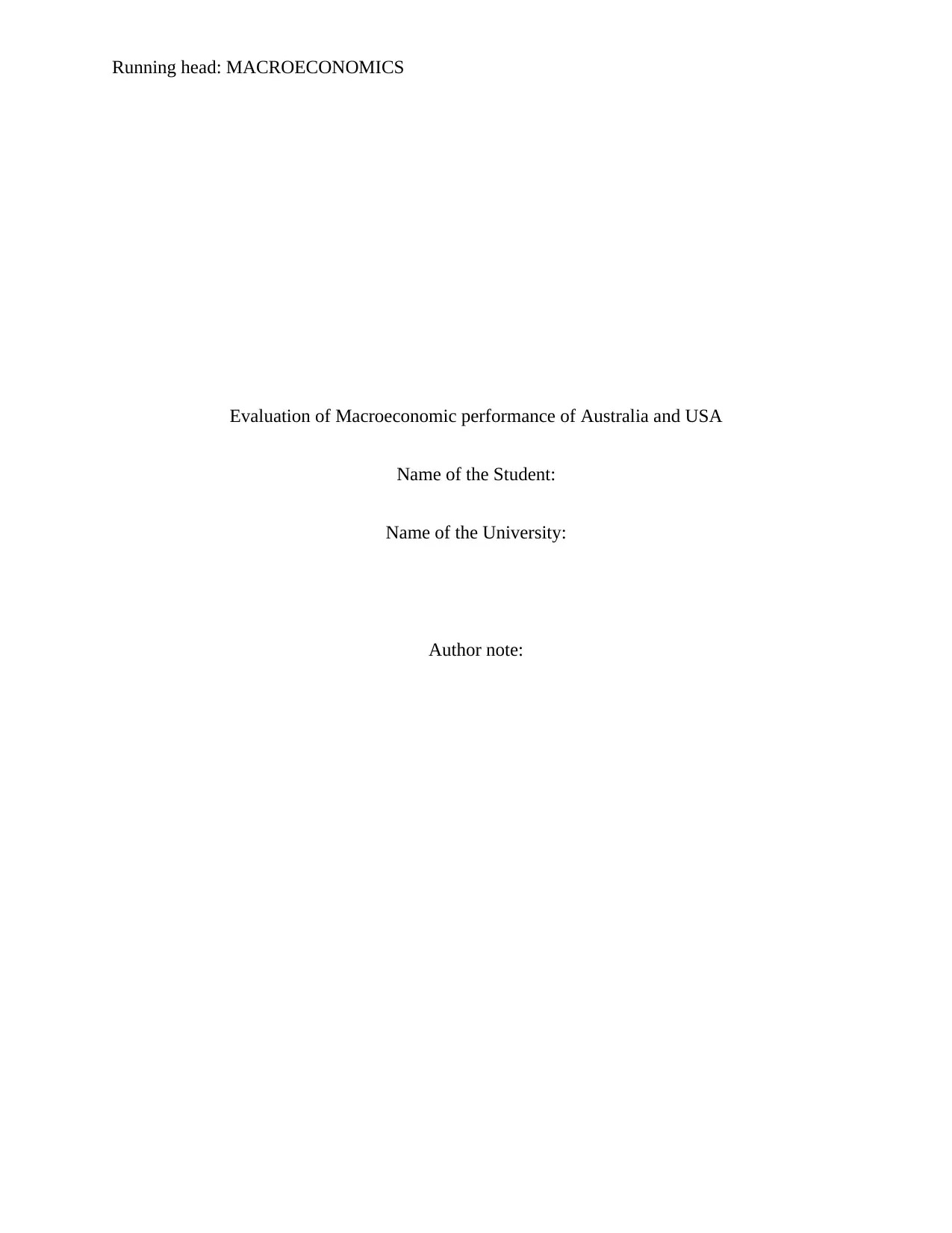
Evaluation of Macroeconomic performance of Australia and USA
Name of the Student:
Name of the University:
Author note:
Paraphrase This Document
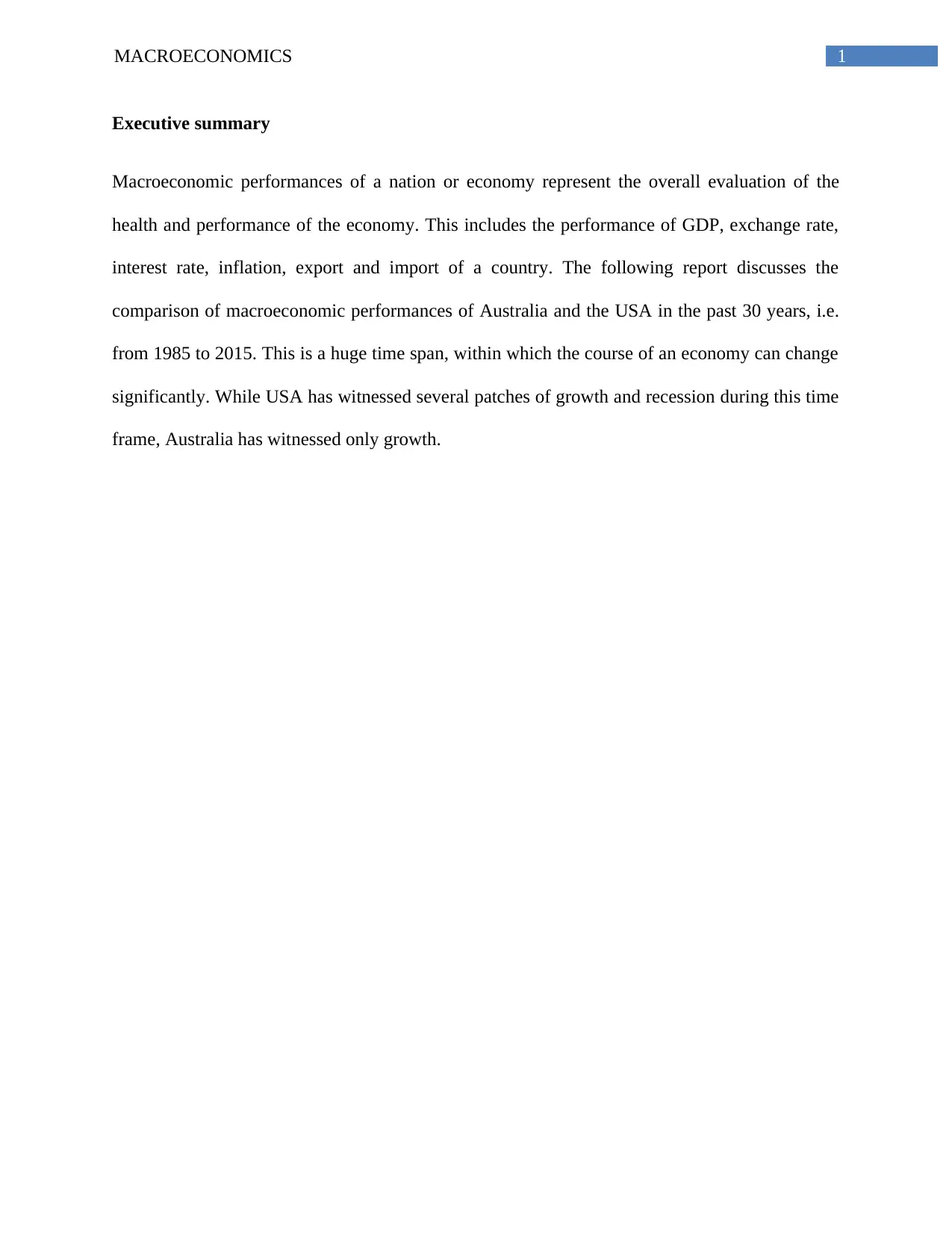
Executive summary
Macroeconomic performances of a nation or economy represent the overall evaluation of the
health and performance of the economy. This includes the performance of GDP, exchange rate,
interest rate, inflation, export and import of a country. The following report discusses the
comparison of macroeconomic performances of Australia and the USA in the past 30 years, i.e.
from 1985 to 2015. This is a huge time span, within which the course of an economy can change
significantly. While USA has witnessed several patches of growth and recession during this time
frame, Australia has witnessed only growth.
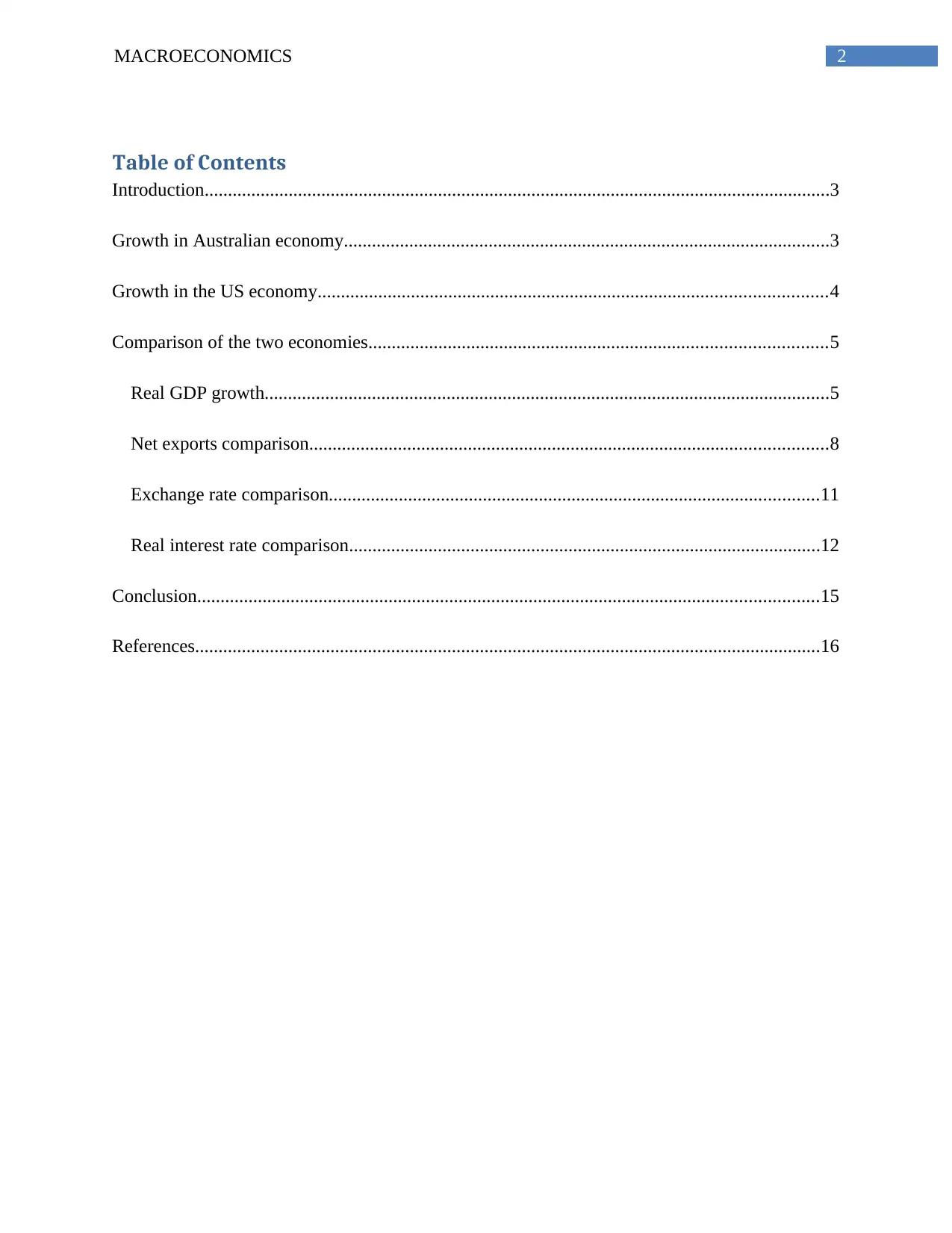
Table of Contents
Introduction......................................................................................................................................3
Growth in Australian economy........................................................................................................3
Growth in the US economy.............................................................................................................4
Comparison of the two economies..................................................................................................5
Real GDP growth.........................................................................................................................5
Net exports comparison...............................................................................................................8
Exchange rate comparison.........................................................................................................11
Real interest rate comparison.....................................................................................................12
Conclusion.....................................................................................................................................15
References......................................................................................................................................16
⊘ This is a preview!⊘
Do you want full access?
Subscribe today to unlock all pages.

Trusted by 1+ million students worldwide
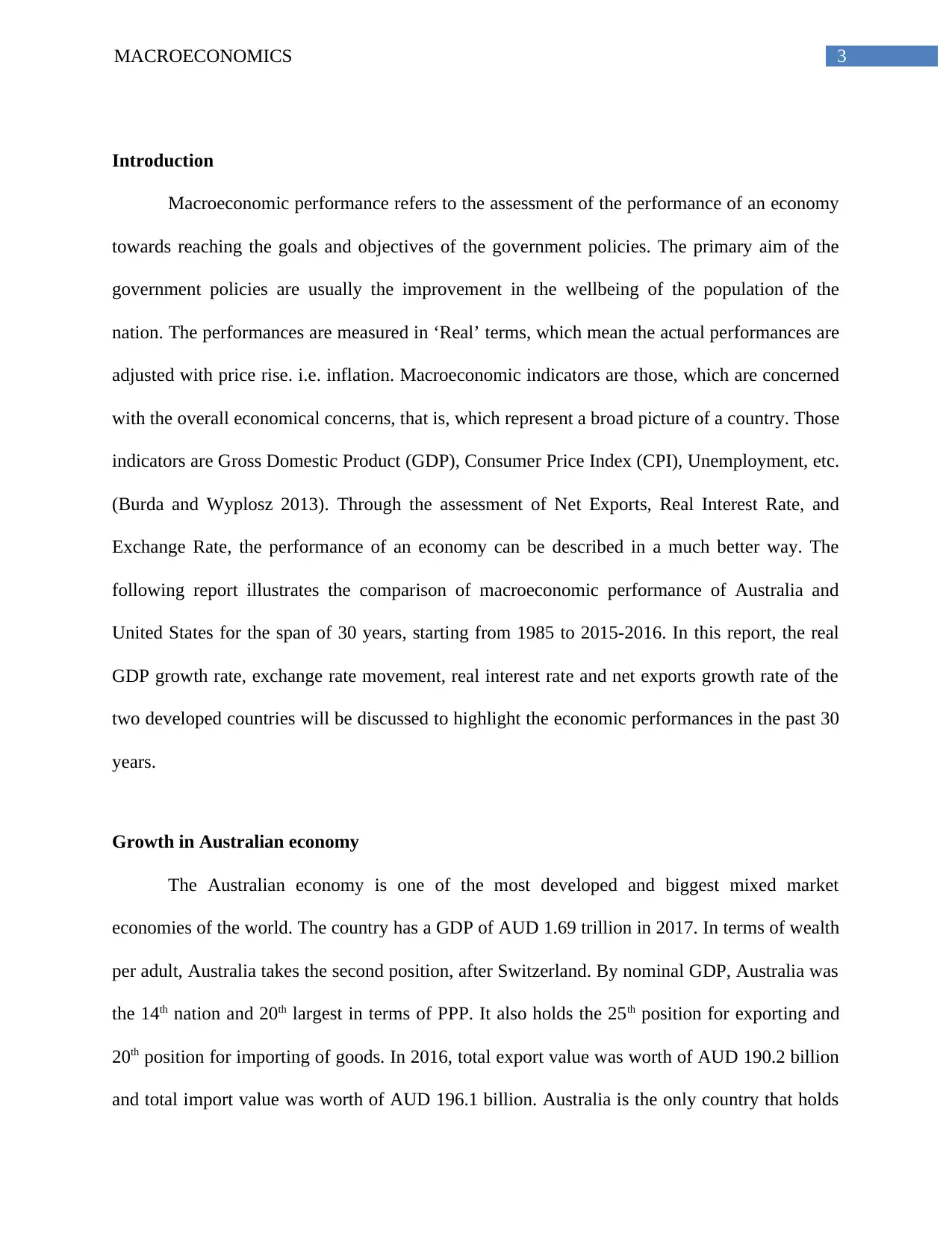
Introduction
Macroeconomic performance refers to the assessment of the performance of an economy
towards reaching the goals and objectives of the government policies. The primary aim of the
government policies are usually the improvement in the wellbeing of the population of the
nation. The performances are measured in ‘Real’ terms, which mean the actual performances are
adjusted with price rise. i.e. inflation. Macroeconomic indicators are those, which are concerned
with the overall economical concerns, that is, which represent a broad picture of a country. Those
indicators are Gross Domestic Product (GDP), Consumer Price Index (CPI), Unemployment, etc.
(Burda and Wyplosz 2013). Through the assessment of Net Exports, Real Interest Rate, and
Exchange Rate, the performance of an economy can be described in a much better way. The
following report illustrates the comparison of macroeconomic performance of Australia and
United States for the span of 30 years, starting from 1985 to 2015-2016. In this report, the real
GDP growth rate, exchange rate movement, real interest rate and net exports growth rate of the
two developed countries will be discussed to highlight the economic performances in the past 30
years.
Growth in Australian economy
The Australian economy is one of the most developed and biggest mixed market
economies of the world. The country has a GDP of AUD 1.69 trillion in 2017. In terms of wealth
per adult, Australia takes the second position, after Switzerland. By nominal GDP, Australia was
the 14th nation and 20th largest in terms of PPP. It also holds the 25th position for exporting and
20th position for importing of goods. In 2016, total export value was worth of AUD 190.2 billion
and total import value was worth of AUD 196.1 billion. Australia is the only country that holds
Paraphrase This Document
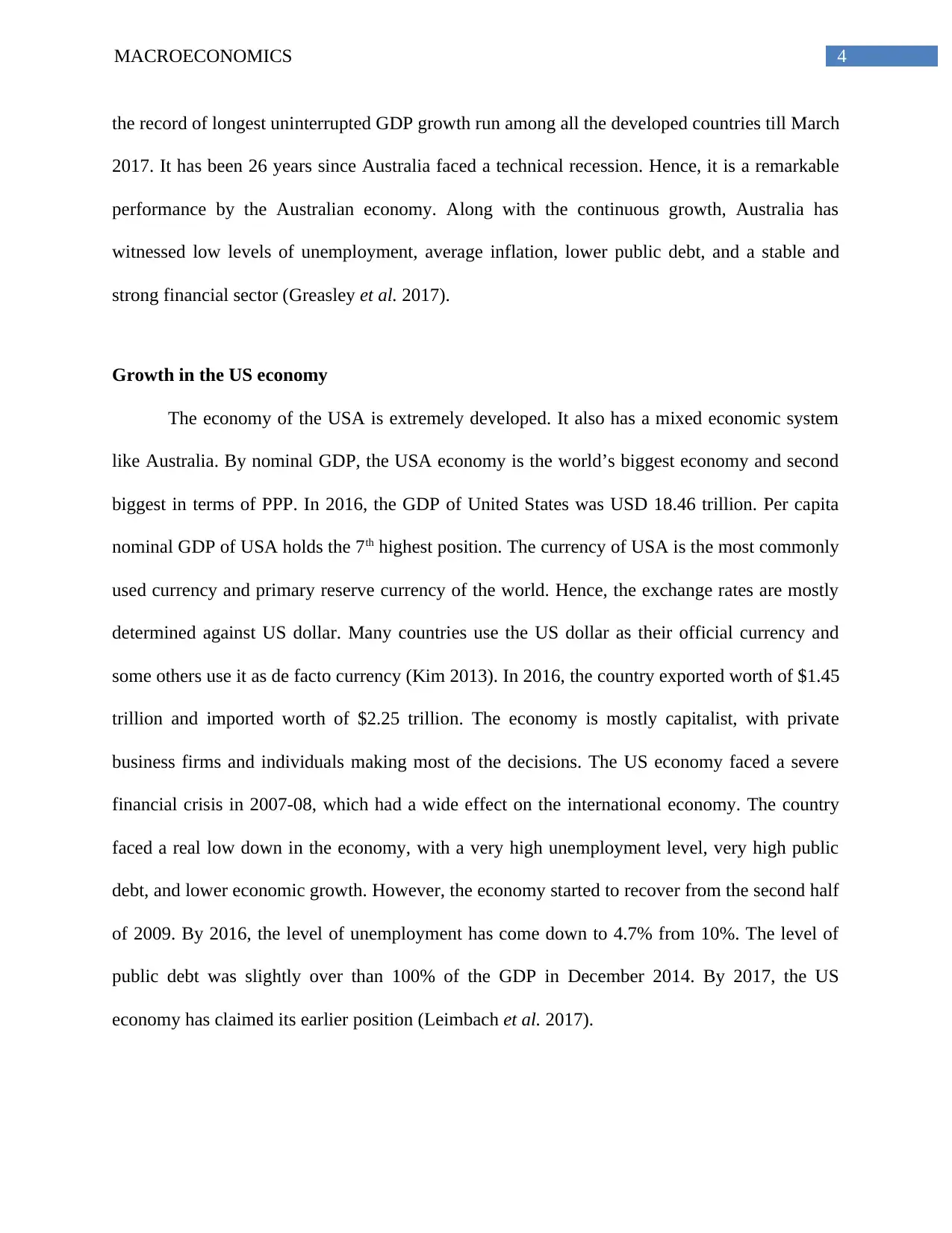
the record of longest uninterrupted GDP growth run among all the developed countries till March
2017. It has been 26 years since Australia faced a technical recession. Hence, it is a remarkable
performance by the Australian economy. Along with the continuous growth, Australia has
witnessed low levels of unemployment, average inflation, lower public debt, and a stable and
strong financial sector (Greasley et al. 2017).
Growth in the US economy
The economy of the USA is extremely developed. It also has a mixed economic system
like Australia. By nominal GDP, the USA economy is the world’s biggest economy and second
biggest in terms of PPP. In 2016, the GDP of United States was USD 18.46 trillion. Per capita
nominal GDP of USA holds the 7th highest position. The currency of USA is the most commonly
used currency and primary reserve currency of the world. Hence, the exchange rates are mostly
determined against US dollar. Many countries use the US dollar as their official currency and
some others use it as de facto currency (Kim 2013). In 2016, the country exported worth of $1.45
trillion and imported worth of $2.25 trillion. The economy is mostly capitalist, with private
business firms and individuals making most of the decisions. The US economy faced a severe
financial crisis in 2007-08, which had a wide effect on the international economy. The country
faced a real low down in the economy, with a very high unemployment level, very high public
debt, and lower economic growth. However, the economy started to recover from the second half
of 2009. By 2016, the level of unemployment has come down to 4.7% from 10%. The level of
public debt was slightly over than 100% of the GDP in December 2014. By 2017, the US
economy has claimed its earlier position (Leimbach et al. 2017).
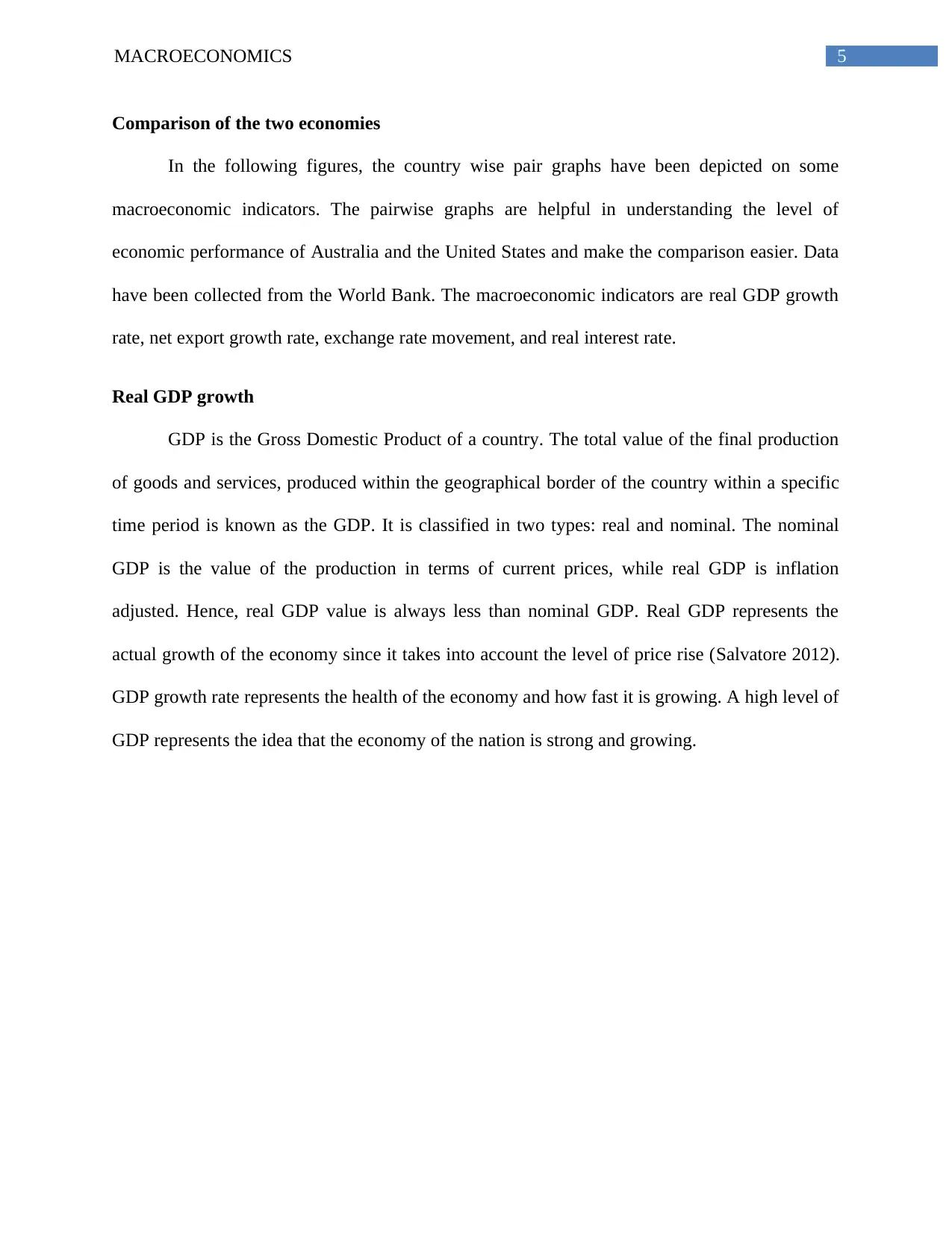
Comparison of the two economies
In the following figures, the country wise pair graphs have been depicted on some
macroeconomic indicators. The pairwise graphs are helpful in understanding the level of
economic performance of Australia and the United States and make the comparison easier. Data
have been collected from the World Bank. The macroeconomic indicators are real GDP growth
rate, net export growth rate, exchange rate movement, and real interest rate.
Real GDP growth
GDP is the Gross Domestic Product of a country. The total value of the final production
of goods and services, produced within the geographical border of the country within a specific
time period is known as the GDP. It is classified in two types: real and nominal. The nominal
GDP is the value of the production in terms of current prices, while real GDP is inflation
adjusted. Hence, real GDP value is always less than nominal GDP. Real GDP represents the
actual growth of the economy since it takes into account the level of price rise (Salvatore 2012).
GDP growth rate represents the health of the economy and how fast it is growing. A high level of
GDP represents the idea that the economy of the nation is strong and growing.
⊘ This is a preview!⊘
Do you want full access?
Subscribe today to unlock all pages.

Trusted by 1+ million students worldwide
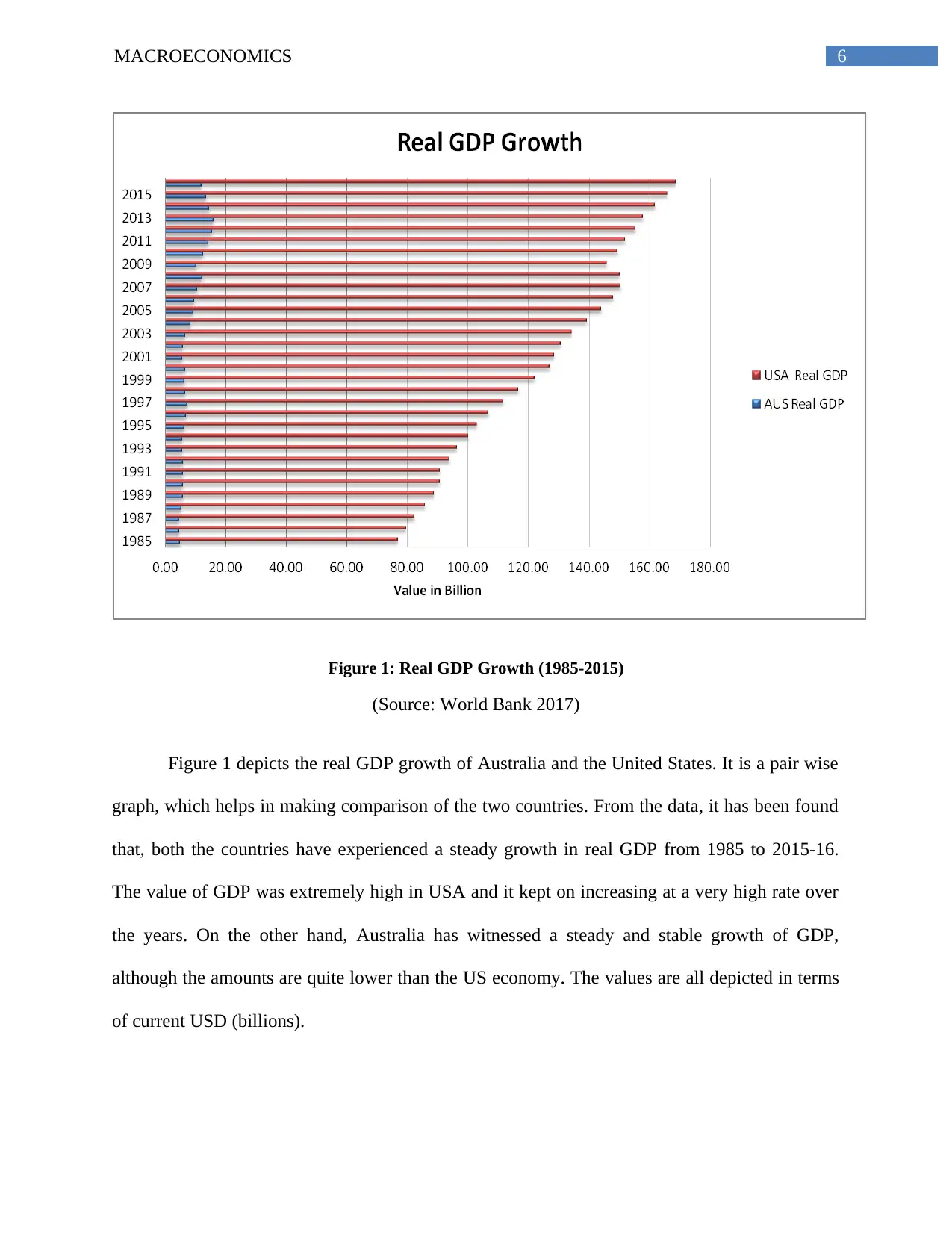
Figure 1: Real GDP Growth (1985-2015)
(Source: World Bank 2017)
Figure 1 depicts the real GDP growth of Australia and the United States. It is a pair wise
graph, which helps in making comparison of the two countries. From the data, it has been found
that, both the countries have experienced a steady growth in real GDP from 1985 to 2015-16.
The value of GDP was extremely high in USA and it kept on increasing at a very high rate over
the years. On the other hand, Australia has witnessed a steady and stable growth of GDP,
although the amounts are quite lower than the US economy. The values are all depicted in terms
of current USD (billions).
Paraphrase This Document
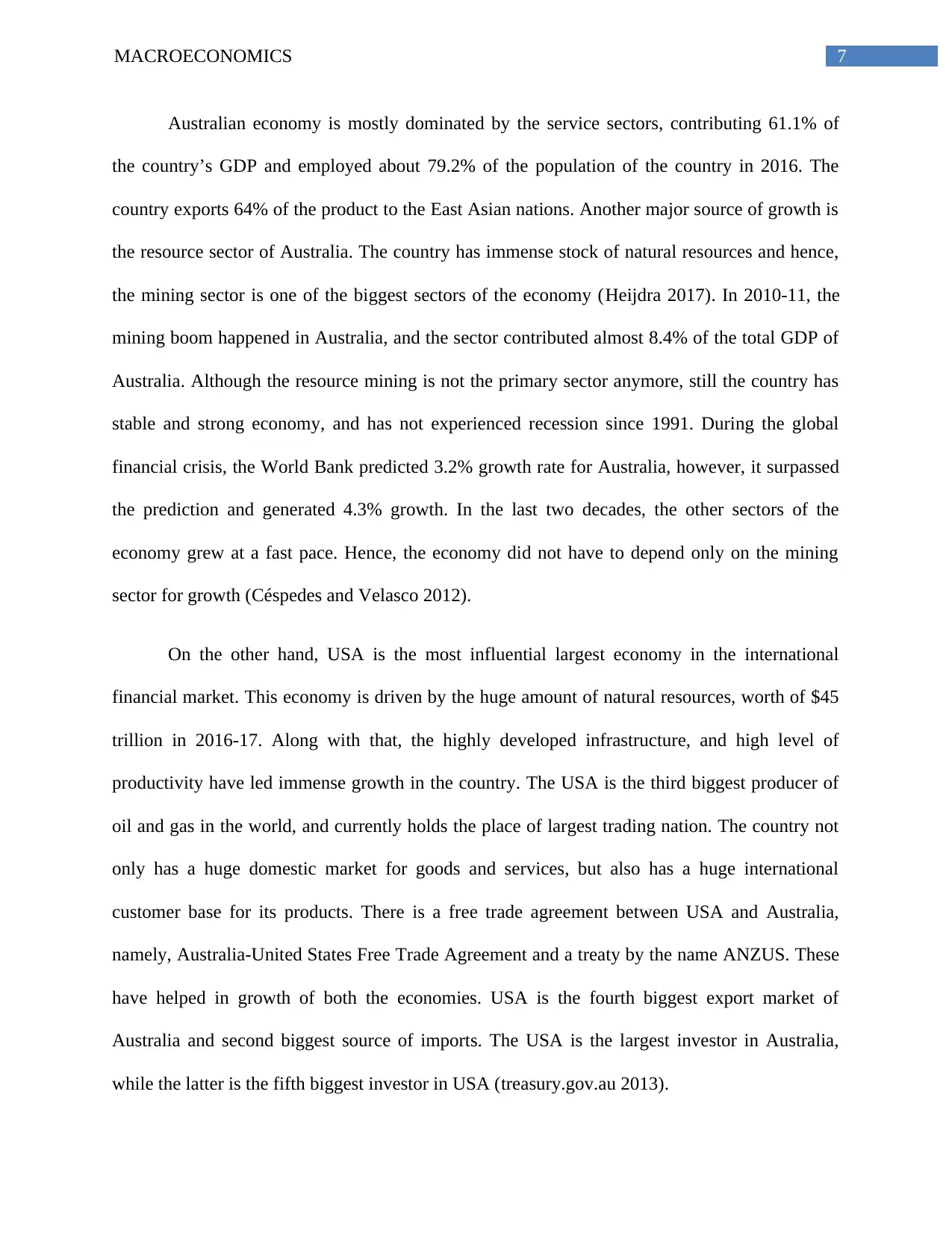
Australian economy is mostly dominated by the service sectors, contributing 61.1% of
the country’s GDP and employed about 79.2% of the population of the country in 2016. The
country exports 64% of the product to the East Asian nations. Another major source of growth is
the resource sector of Australia. The country has immense stock of natural resources and hence,
the mining sector is one of the biggest sectors of the economy (Heijdra 2017). In 2010-11, the
mining boom happened in Australia, and the sector contributed almost 8.4% of the total GDP of
Australia. Although the resource mining is not the primary sector anymore, still the country has
stable and strong economy, and has not experienced recession since 1991. During the global
financial crisis, the World Bank predicted 3.2% growth rate for Australia, however, it surpassed
the prediction and generated 4.3% growth. In the last two decades, the other sectors of the
economy grew at a fast pace. Hence, the economy did not have to depend only on the mining
sector for growth (Céspedes and Velasco 2012).
On the other hand, USA is the most influential largest economy in the international
financial market. This economy is driven by the huge amount of natural resources, worth of $45
trillion in 2016-17. Along with that, the highly developed infrastructure, and high level of
productivity have led immense growth in the country. The USA is the third biggest producer of
oil and gas in the world, and currently holds the place of largest trading nation. The country not
only has a huge domestic market for goods and services, but also has a huge international
customer base for its products. There is a free trade agreement between USA and Australia,
namely, Australia-United States Free Trade Agreement and a treaty by the name ANZUS. These
have helped in growth of both the economies. USA is the fourth biggest export market of
Australia and second biggest source of imports. The USA is the largest investor in Australia,
while the latter is the fifth biggest investor in USA (treasury.gov.au 2013).

1985
1987
1989
1991
1993
1995
1997
1999
2001
2003
2005
2007
2009
2011
2013
2015
-0.15
-0.10
-0.05
0.00
0.05
0.10
0.15
0.20
0.25
0.30
0.35
Growth Rate (%)
AUS
USA
Growth Rate (%)
Figure 2: Real GDP Growth Rate (%)
(Source: World Bank 2017)
From the above graph, it can be seen that, over the years, USA has a steady growth rate,
while the growth rate of Australia has been very much fluctuating. However, the growth rate has
been mostly positive in these 30 years. While, USA has experienced a stable growth without
much high fluctuations.
Net exports comparison
Another major macroeconomic indicator is the net exports. Net export is the difference
between exports and imports of a country. The net export represents the export and import level
of the country. When the export is higher than imports, the value of net exports is positive and
when import value is higher than export, the net export value is negative. This indicates the
⊘ This is a preview!⊘
Do you want full access?
Subscribe today to unlock all pages.

Trusted by 1+ million students worldwide
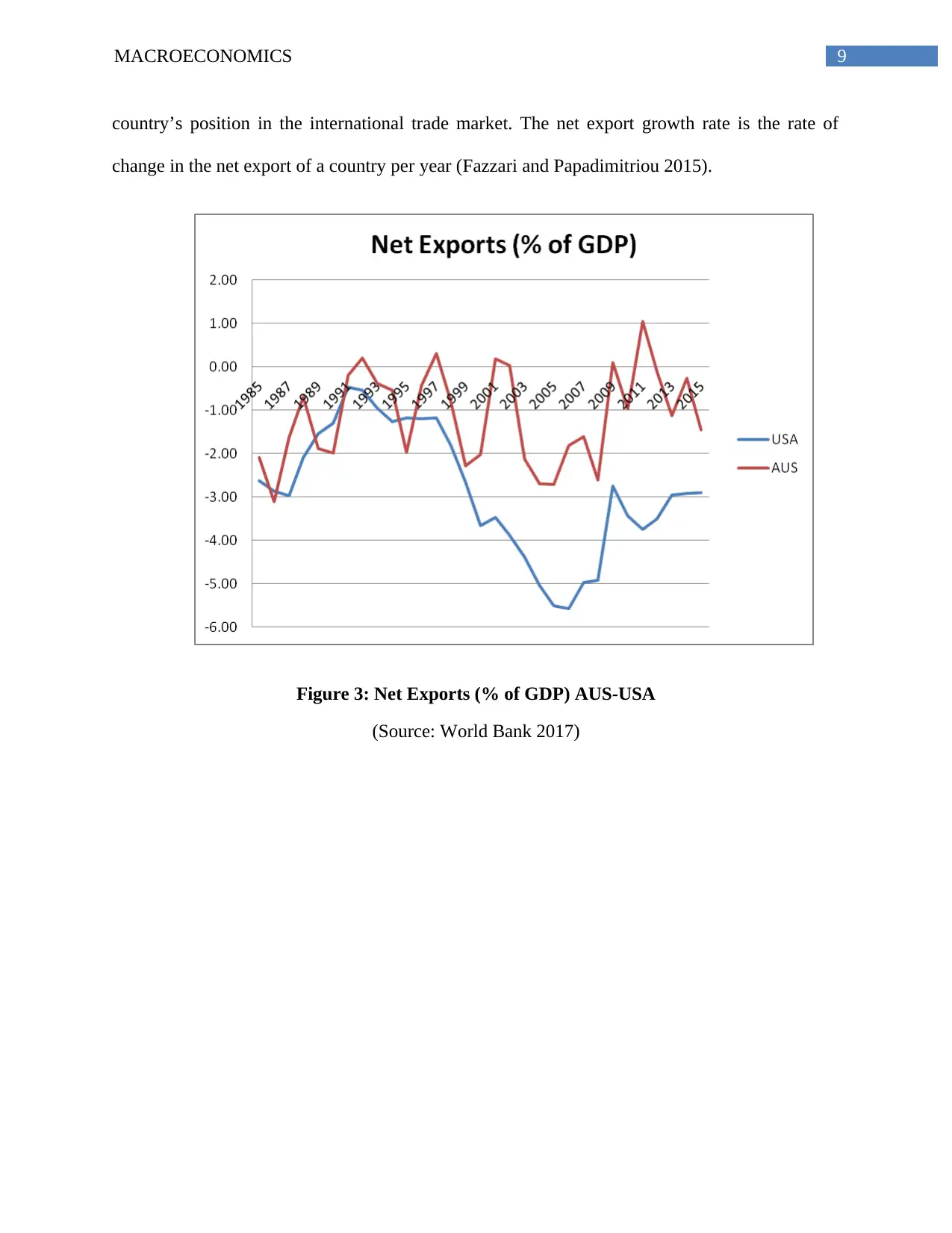
country’s position in the international trade market. The net export growth rate is the rate of
change in the net export of a country per year (Fazzari and Papadimitriou 2015).
Figure 3: Net Exports (% of GDP) AUS-USA
(Source: World Bank 2017)
Paraphrase This Document
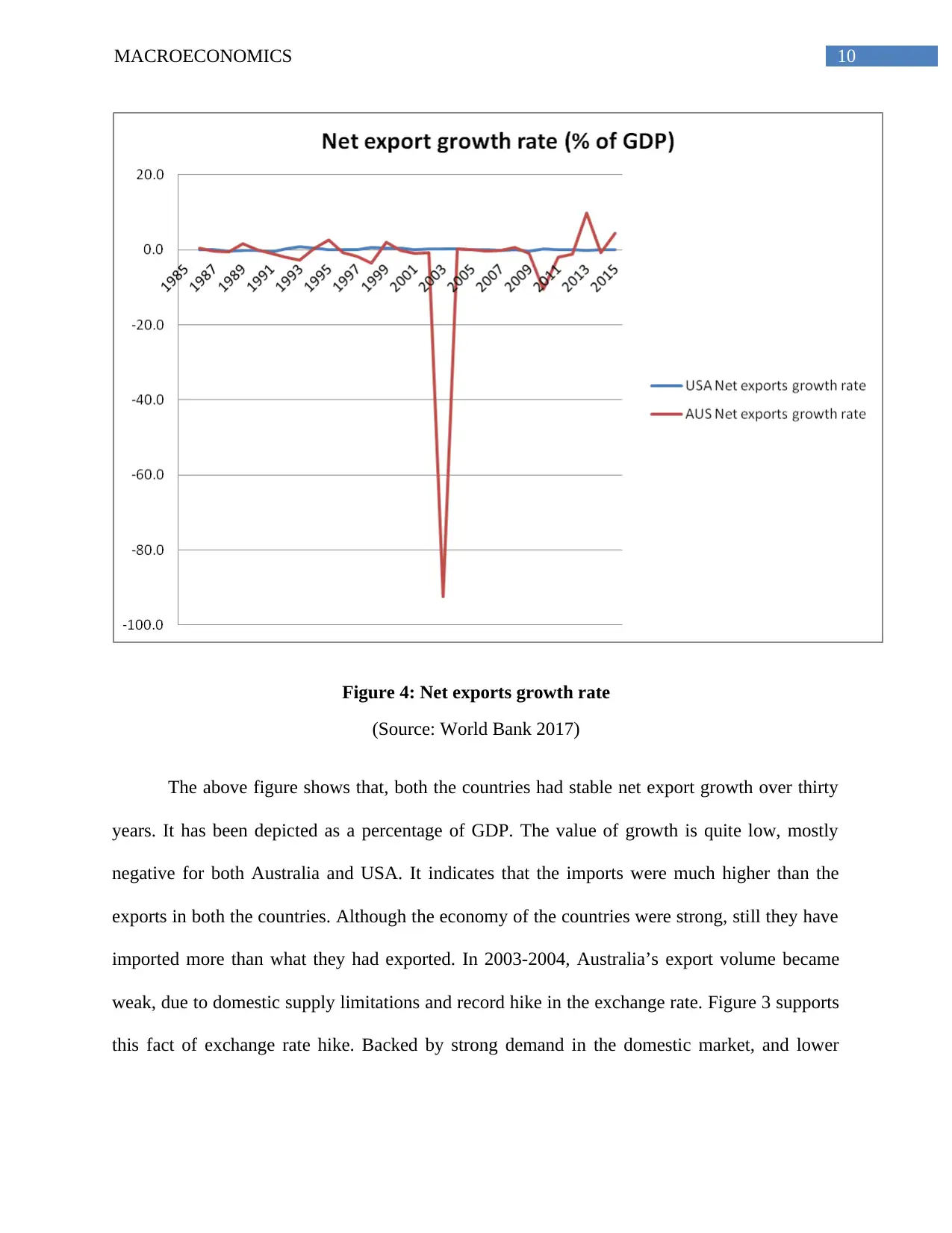
Figure 4: Net exports growth rate
(Source: World Bank 2017)
The above figure shows that, both the countries had stable net export growth over thirty
years. It has been depicted as a percentage of GDP. The value of growth is quite low, mostly
negative for both Australia and USA. It indicates that the imports were much higher than the
exports in both the countries. Although the economy of the countries were strong, still they have
imported more than what they had exported. In 2003-2004, Australia’s export volume became
weak, due to domestic supply limitations and record hike in the exchange rate. Figure 3 supports
this fact of exchange rate hike. Backed by strong demand in the domestic market, and lower
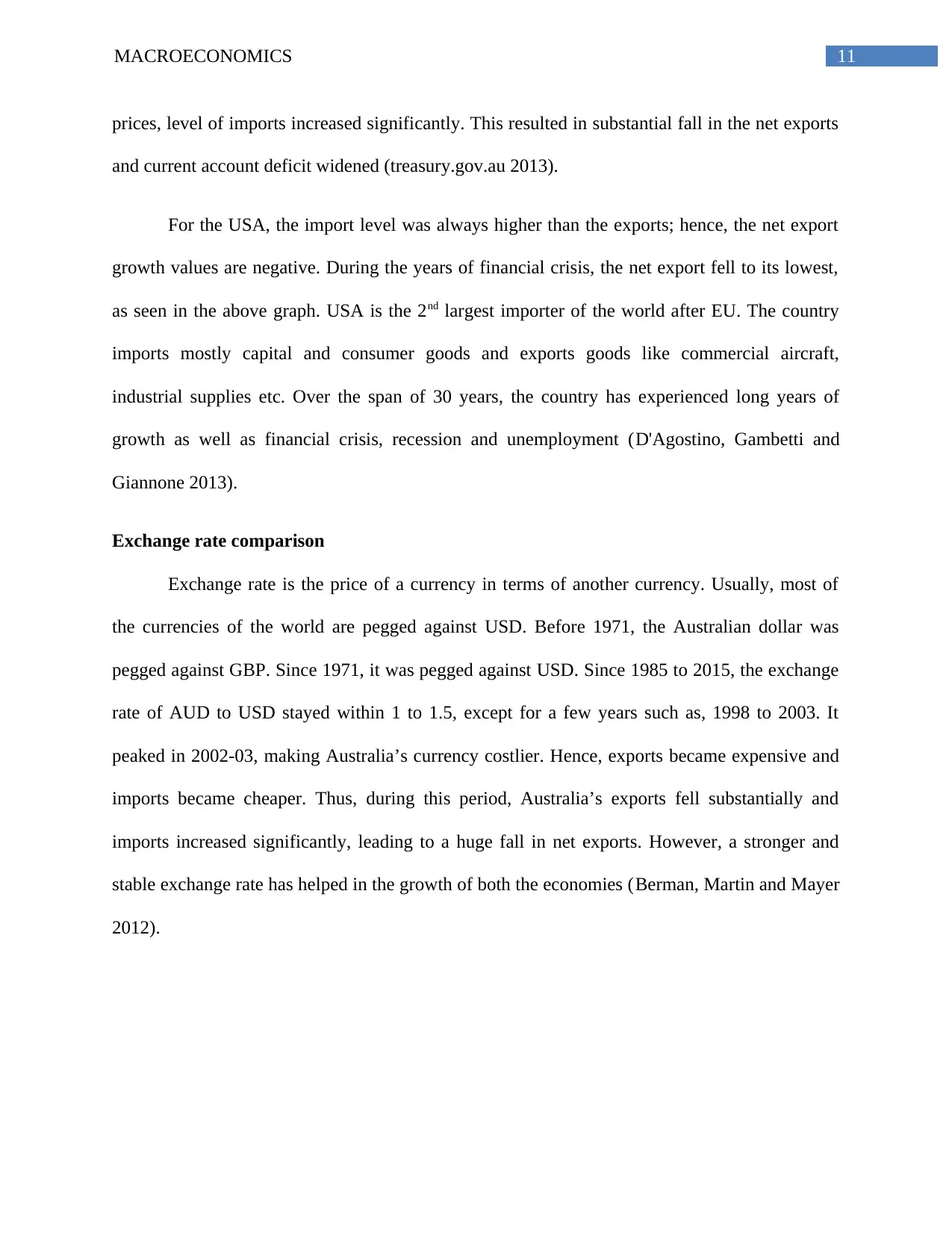
prices, level of imports increased significantly. This resulted in substantial fall in the net exports
and current account deficit widened (treasury.gov.au 2013).
For the USA, the import level was always higher than the exports; hence, the net export
growth values are negative. During the years of financial crisis, the net export fell to its lowest,
as seen in the above graph. USA is the 2nd largest importer of the world after EU. The country
imports mostly capital and consumer goods and exports goods like commercial aircraft,
industrial supplies etc. Over the span of 30 years, the country has experienced long years of
growth as well as financial crisis, recession and unemployment (D'Agostino, Gambetti and
Giannone 2013).
Exchange rate comparison
Exchange rate is the price of a currency in terms of another currency. Usually, most of
the currencies of the world are pegged against USD. Before 1971, the Australian dollar was
pegged against GBP. Since 1971, it was pegged against USD. Since 1985 to 2015, the exchange
rate of AUD to USD stayed within 1 to 1.5, except for a few years such as, 1998 to 2003. It
peaked in 2002-03, making Australia’s currency costlier. Hence, exports became expensive and
imports became cheaper. Thus, during this period, Australia’s exports fell substantially and
imports increased significantly, leading to a huge fall in net exports. However, a stronger and
stable exchange rate has helped in the growth of both the economies (Berman, Martin and Mayer
2012).
⊘ This is a preview!⊘
Do you want full access?
Subscribe today to unlock all pages.

Trusted by 1+ million students worldwide
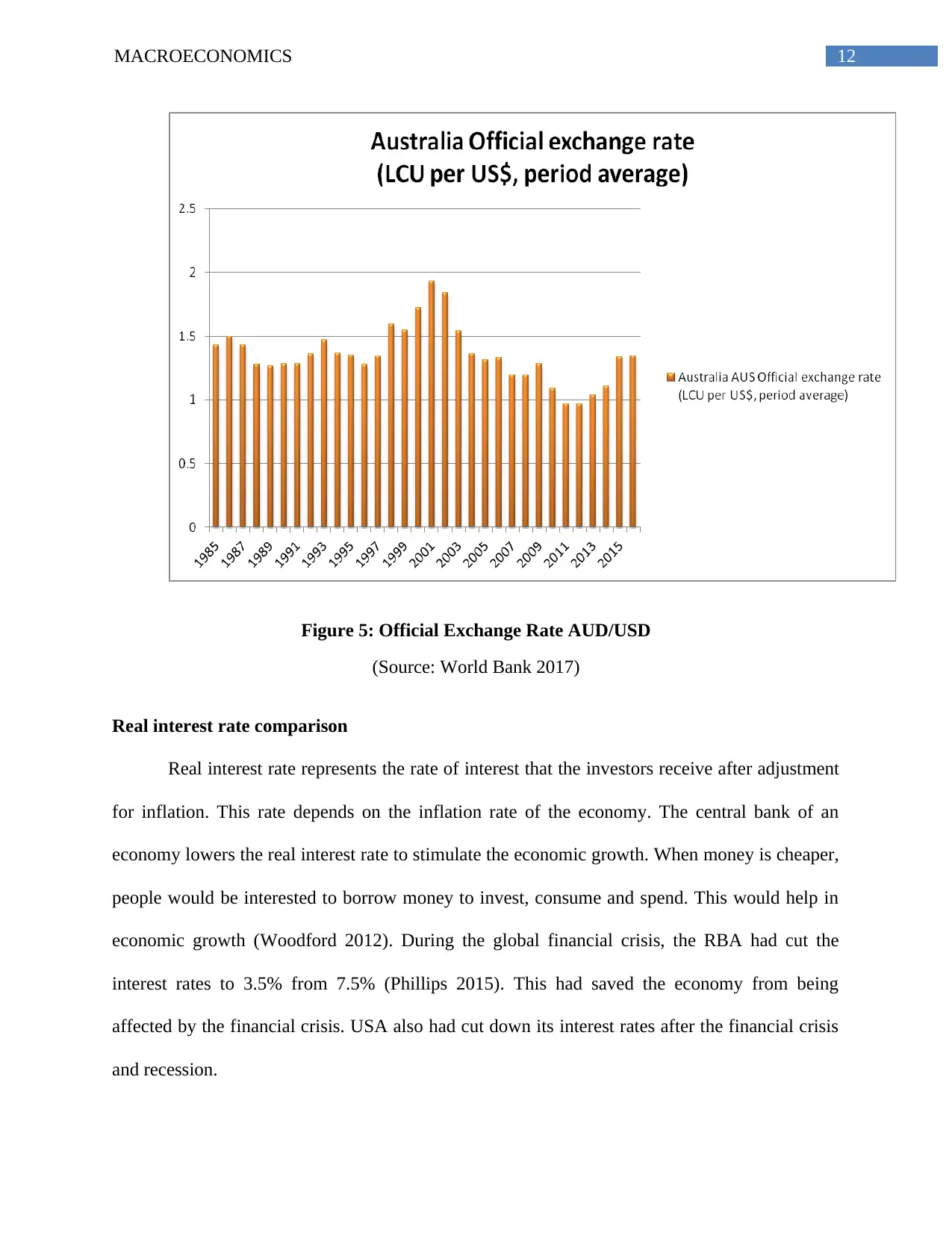
Figure 5: Official Exchange Rate AUD/USD
(Source: World Bank 2017)
Real interest rate comparison
Real interest rate represents the rate of interest that the investors receive after adjustment
for inflation. This rate depends on the inflation rate of the economy. The central bank of an
economy lowers the real interest rate to stimulate the economic growth. When money is cheaper,
people would be interested to borrow money to invest, consume and spend. This would help in
economic growth (Woodford 2012). During the global financial crisis, the RBA had cut the
interest rates to 3.5% from 7.5% (Phillips 2015). This had saved the economy from being
affected by the financial crisis. USA also had cut down its interest rates after the financial crisis
and recession.
Paraphrase This Document
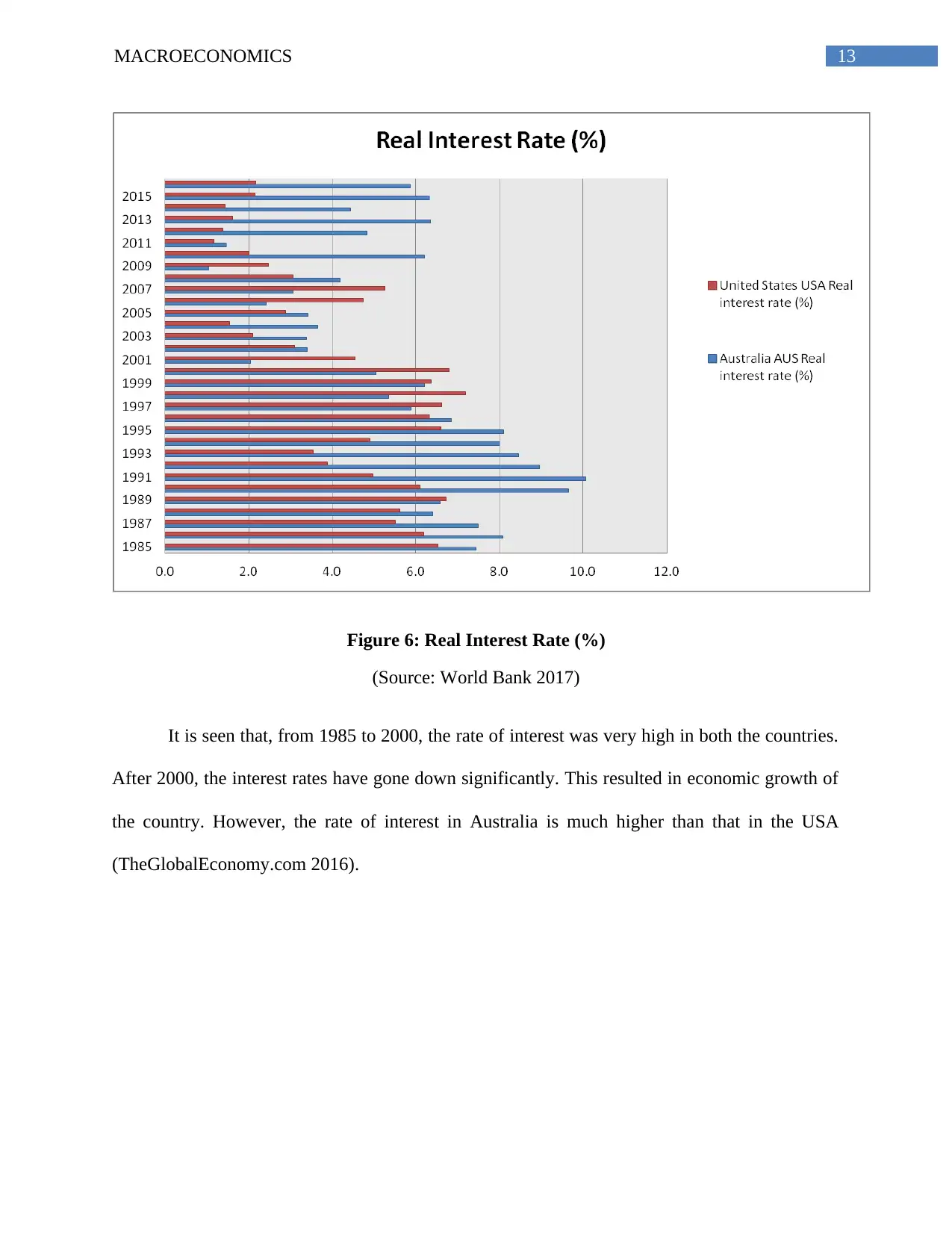
Figure 6: Real Interest Rate (%)
(Source: World Bank 2017)
It is seen that, from 1985 to 2000, the rate of interest was very high in both the countries.
After 2000, the interest rates have gone down significantly. This resulted in economic growth of
the country. However, the rate of interest in Australia is much higher than that in the USA
(TheGlobalEconomy.com 2016).
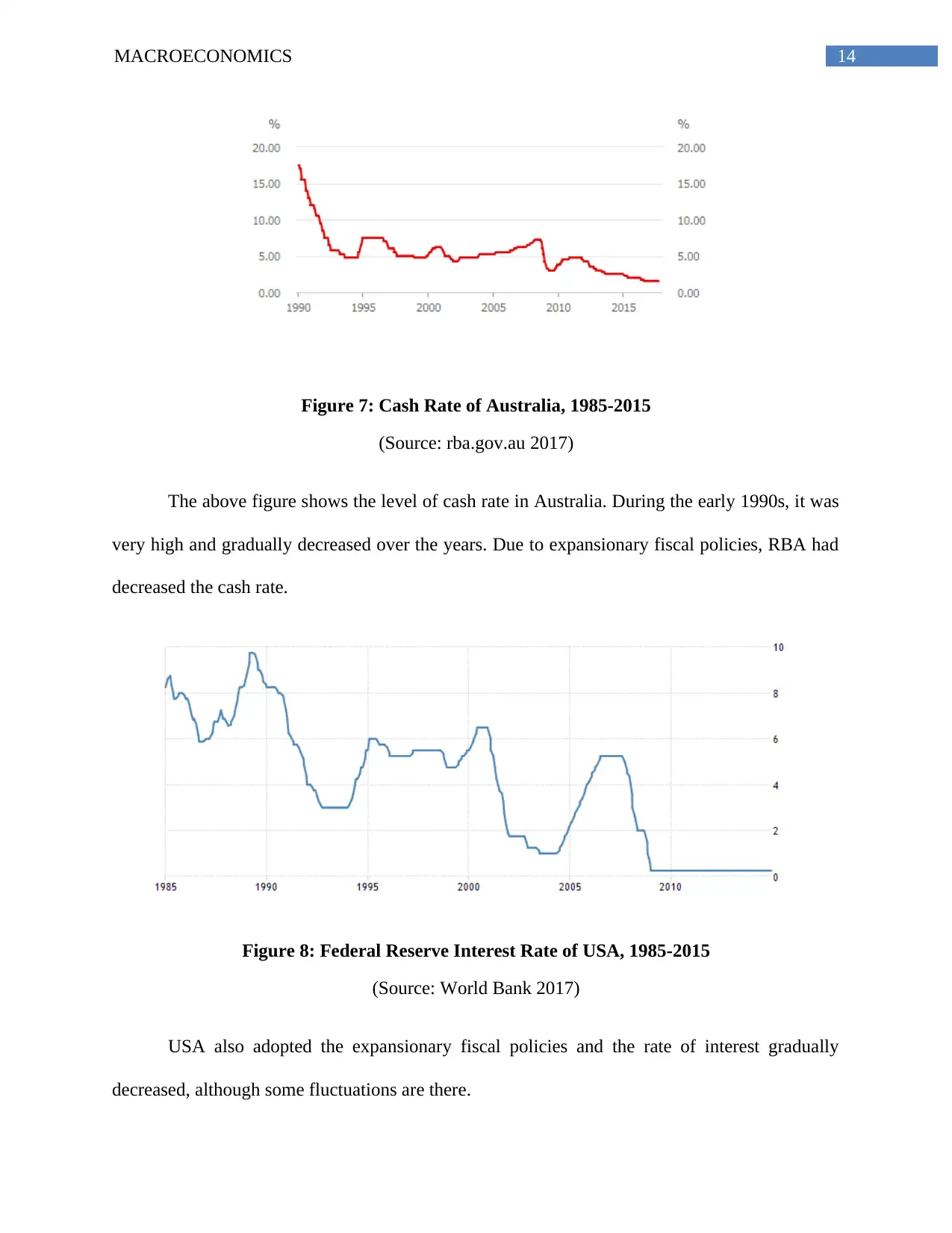
Figure 7: Cash Rate of Australia, 1985-2015
(Source: rba.gov.au 2017)
The above figure shows the level of cash rate in Australia. During the early 1990s, it was
very high and gradually decreased over the years. Due to expansionary fiscal policies, RBA had
decreased the cash rate.
Figure 8: Federal Reserve Interest Rate of USA, 1985-2015
(Source: World Bank 2017)
USA also adopted the expansionary fiscal policies and the rate of interest gradually
decreased, although some fluctuations are there.
⊘ This is a preview!⊘
Do you want full access?
Subscribe today to unlock all pages.

Trusted by 1+ million students worldwide
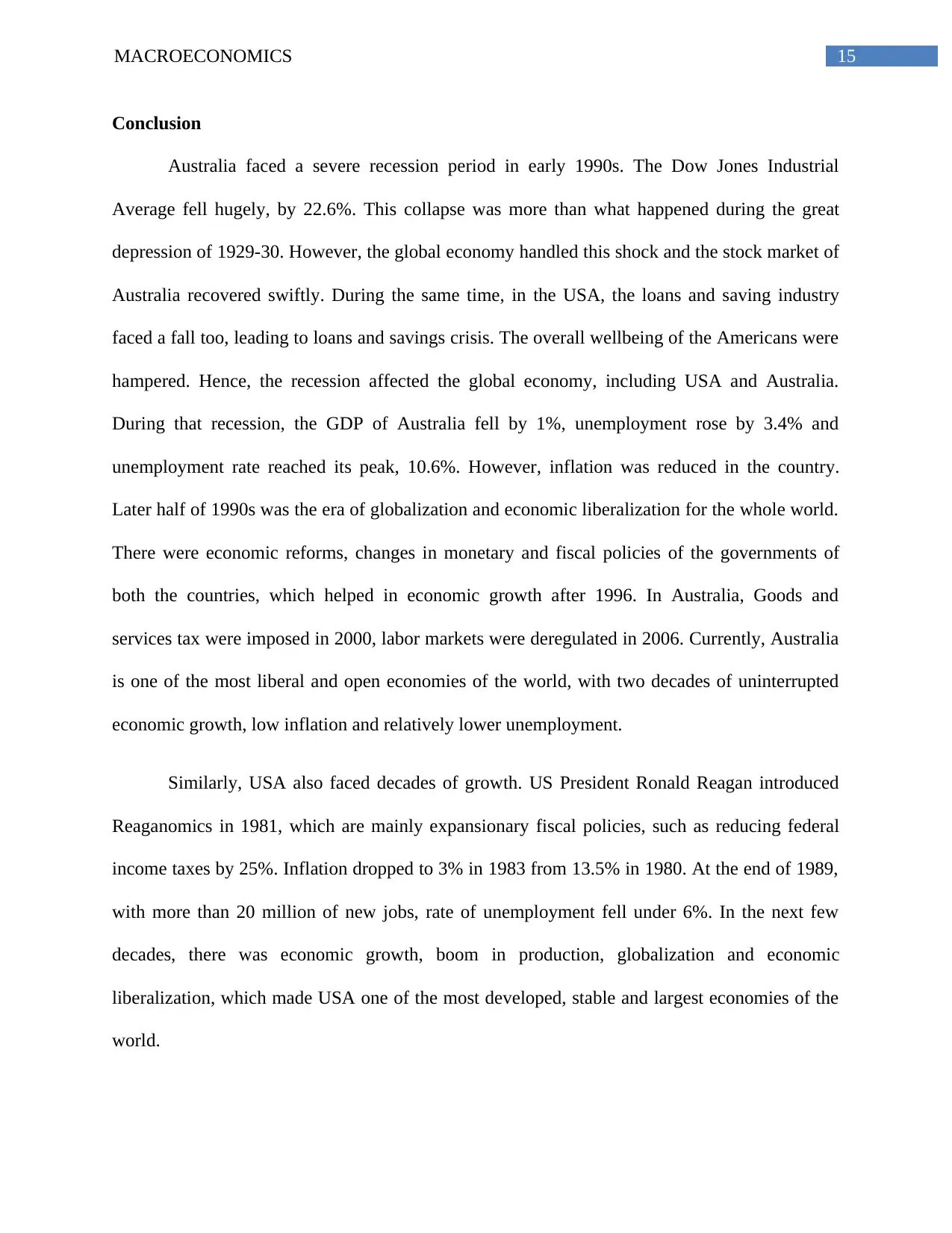
Conclusion
Australia faced a severe recession period in early 1990s. The Dow Jones Industrial
Average fell hugely, by 22.6%. This collapse was more than what happened during the great
depression of 1929-30. However, the global economy handled this shock and the stock market of
Australia recovered swiftly. During the same time, in the USA, the loans and saving industry
faced a fall too, leading to loans and savings crisis. The overall wellbeing of the Americans were
hampered. Hence, the recession affected the global economy, including USA and Australia.
During that recession, the GDP of Australia fell by 1%, unemployment rose by 3.4% and
unemployment rate reached its peak, 10.6%. However, inflation was reduced in the country.
Later half of 1990s was the era of globalization and economic liberalization for the whole world.
There were economic reforms, changes in monetary and fiscal policies of the governments of
both the countries, which helped in economic growth after 1996. In Australia, Goods and
services tax were imposed in 2000, labor markets were deregulated in 2006. Currently, Australia
is one of the most liberal and open economies of the world, with two decades of uninterrupted
economic growth, low inflation and relatively lower unemployment.
Similarly, USA also faced decades of growth. US President Ronald Reagan introduced
Reaganomics in 1981, which are mainly expansionary fiscal policies, such as reducing federal
income taxes by 25%. Inflation dropped to 3% in 1983 from 13.5% in 1980. At the end of 1989,
with more than 20 million of new jobs, rate of unemployment fell under 6%. In the next few
decades, there was economic growth, boom in production, globalization and economic
liberalization, which made USA one of the most developed, stable and largest economies of the
world.
Paraphrase This Document
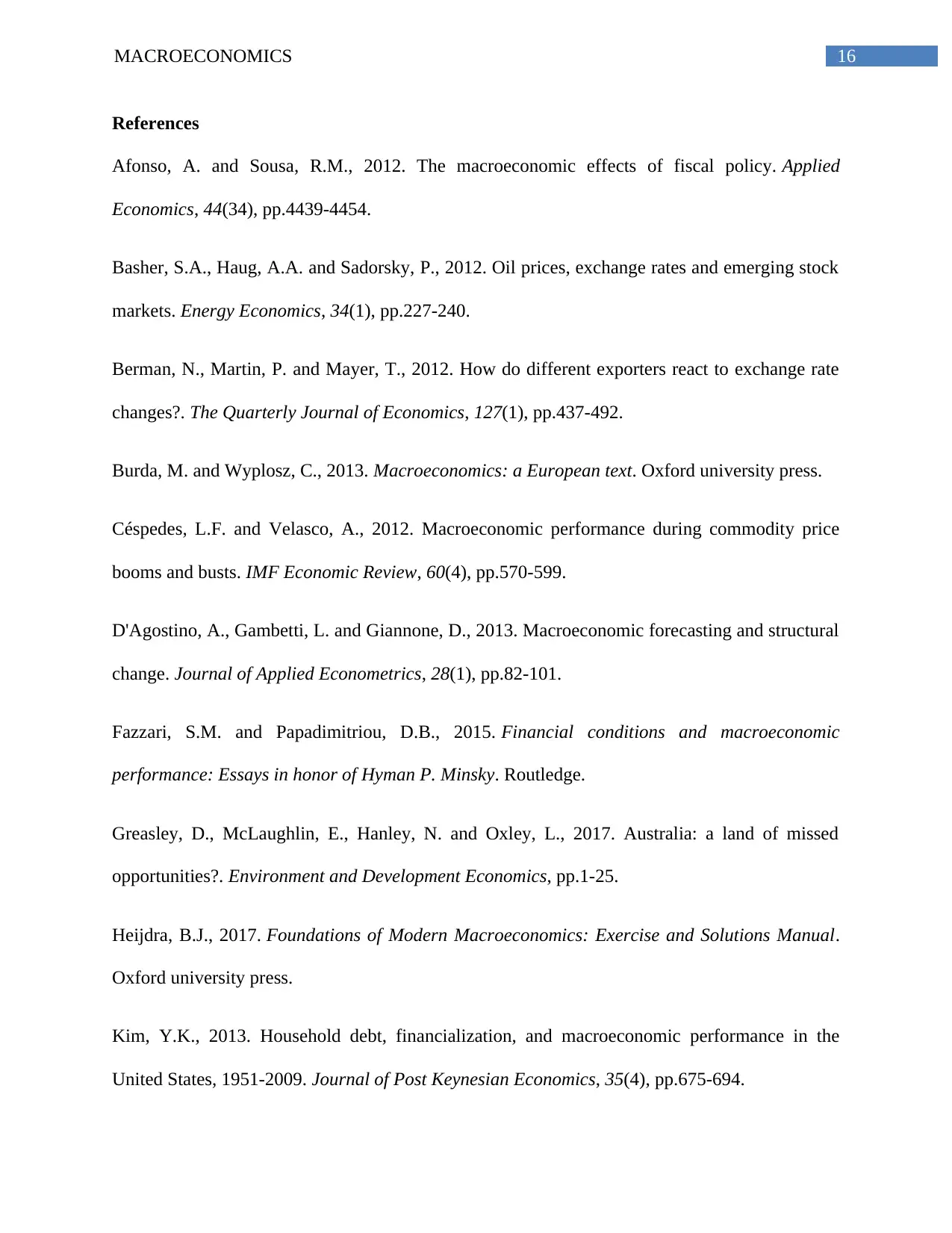
References
Afonso, A. and Sousa, R.M., 2012. The macroeconomic effects of fiscal policy. Applied
Economics, 44(34), pp.4439-4454.
Basher, S.A., Haug, A.A. and Sadorsky, P., 2012. Oil prices, exchange rates and emerging stock
markets. Energy Economics, 34(1), pp.227-240.
Berman, N., Martin, P. and Mayer, T., 2012. How do different exporters react to exchange rate
changes?. The Quarterly Journal of Economics, 127(1), pp.437-492.
Burda, M. and Wyplosz, C., 2013. Macroeconomics: a European text. Oxford university press.
Céspedes, L.F. and Velasco, A., 2012. Macroeconomic performance during commodity price
booms and busts. IMF Economic Review, 60(4), pp.570-599.
D'Agostino, A., Gambetti, L. and Giannone, D., 2013. Macroeconomic forecasting and structural
change. Journal of Applied Econometrics, 28(1), pp.82-101.
Fazzari, S.M. and Papadimitriou, D.B., 2015. Financial conditions and macroeconomic
performance: Essays in honor of Hyman P. Minsky. Routledge.
Greasley, D., McLaughlin, E., Hanley, N. and Oxley, L., 2017. Australia: a land of missed
opportunities?. Environment and Development Economics, pp.1-25.
Heijdra, B.J., 2017. Foundations of Modern Macroeconomics: Exercise and Solutions Manual.
Oxford university press.
Kim, Y.K., 2013. Household debt, financialization, and macroeconomic performance in the
United States, 1951-2009. Journal of Post Keynesian Economics, 35(4), pp.675-694.
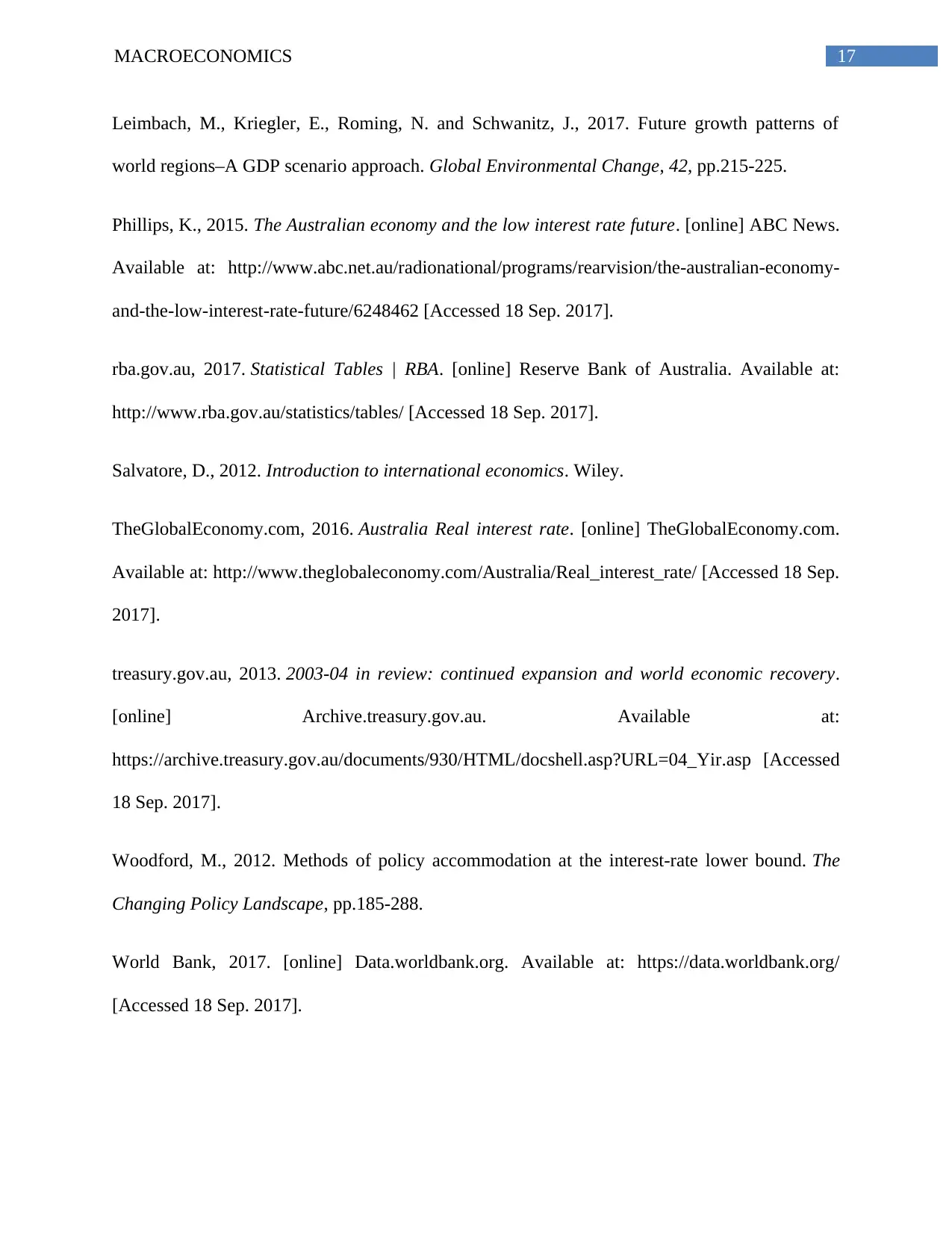
Leimbach, M., Kriegler, E., Roming, N. and Schwanitz, J., 2017. Future growth patterns of
world regions–A GDP scenario approach. Global Environmental Change, 42, pp.215-225.
Phillips, K., 2015. The Australian economy and the low interest rate future. [online] ABC News.
Available at: http://www.abc.net.au/radionational/programs/rearvision/the-australian-economy-
and-the-low-interest-rate-future/6248462 [Accessed 18 Sep. 2017].
rba.gov.au, 2017. Statistical Tables | RBA. [online] Reserve Bank of Australia. Available at:
http://www.rba.gov.au/statistics/tables/ [Accessed 18 Sep. 2017].
Salvatore, D., 2012. Introduction to international economics. Wiley.
TheGlobalEconomy.com, 2016. Australia Real interest rate. [online] TheGlobalEconomy.com.
Available at: http://www.theglobaleconomy.com/Australia/Real_interest_rate/ [Accessed 18 Sep.
2017].
treasury.gov.au, 2013. 2003-04 in review: continued expansion and world economic recovery.
[online] Archive.treasury.gov.au. Available at:
https://archive.treasury.gov.au/documents/930/HTML/docshell.asp?URL=04_Yir.asp [Accessed
18 Sep. 2017].
Woodford, M., 2012. Methods of policy accommodation at the interest-rate lower bound. The
Changing Policy Landscape, pp.185-288.
World Bank, 2017. [online] Data.worldbank.org. Available at: https://data.worldbank.org/
[Accessed 18 Sep. 2017].
⊘ This is a preview!⊘
Do you want full access?
Subscribe today to unlock all pages.

Trusted by 1+ million students worldwide
Related Documents
Your All-in-One AI-Powered Toolkit for Academic Success.
+13062052269
info@desklib.com
Available 24*7 on WhatsApp / Email
![[object Object]](/_next/static/media/star-bottom.7253800d.svg)
© 2024 | Zucol Services PVT LTD | All rights reserved.




